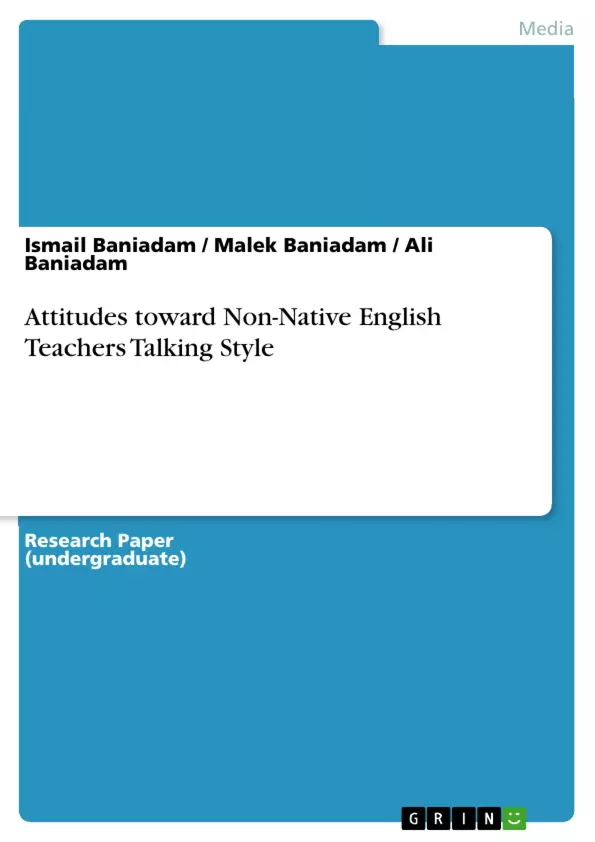This study aimed at investigating the MA EFL learners‘attitudes toward some features of teacher talk regarding gender and experience of teaching in Iranian context. During the study, MA students of TEFL courses in Urmia University were selected as the population of the study. To begin with, 60 male and 60 female EFL MA students were selected as the participants. The instrument used in this study was a researcher made questionnaire which was initially piloted. The questionnaires were distributed among the subjects at the end of their class time with the cooperation of their English teachers in some classes. It took the participants roughly 20 minutes to fill out the questionnaire which included Likert-type questions. Based on the findings of the study it was revealed that the most and least important factor for the students regarding the teachers talk are visual and extra-linguistic information the use of Persian language respectively. Additionally, comparing the four different factors regarding the features of teacher talk, it was revealed that Visual and extra-linguistic information factor, Lexical and syntactic familiarity, Speed of speech and the use of Persian language had the highest to the lowest mean score respectively. It was also indicated that female students rather than male students were significantly more in favor of speed of speech and lexical and syntactic familiarity. Moreover, it was concluded that teaching experienced students rather than non-experienced students had higher mean scores in attitudes to Visual and extra-linguistic information.
Inhaltsverzeichnis (Table of Contents)
- CHAPTER ONE: INTRODUCTION
- 1.1. Background
- 1.2. Statement of the Problem
- 1.3. Significance of the Study
- 1.4. The Purpose of the Study
- 1.5. Research Questions.
- 1.6. Research Hypotheses.......
- 1.7. Definition of Key Terms
- 1.8. Organization of the Study.
- CHAPTER TWO: REVIEW OF THE RELATED LITERATURE
- 2.1. Introduction ......
- 2.2. Theoretical Background.
- 2.2.1. Insights from Foreigner Talk to Teacher Talk.
- 2.2.2. Foreign Language Context.
- 2.2.3. The Significance of Teacher Talk in Foreign Language Acquisition......
- 2.2.4. Modified Input and Teacher Talk.
- 2.2.5. The Characteristics of Teacher Talk....
- 2.2.6. The Use of Mother Tongue in Teacher Talk .\li>
- 2.2.7. Related Theories.
- 2.3. Empirical Background....
- 2.3.1. Lexical and Syntactic Familiarity of Teacher Talk
- 2.3.2. Phonological Features of Teacher Talk (Speed of Speech)...
- 2.3.3. The Use of Visual and Extralinguistic Information in Teacher Talk.
- 2.4. Chapter Summary (Embedded Gap in the Literature).
- CHAPTER THREE: THE METHODOLOGY OF THE STUDY.
- 3.1. Introduction
- 3.2. Design of the Study.
- 3.3. Variables.........
- 3.4. Setting and Participants .\li>
- 3.5. Data Collection Instrument
- 3.6. Data Collection Procedure........
- 3.6.1. Piloting the Questionnaire.
- 3.6.2. Reliability and Validity
- 3.6.3. Administration of the Questionnaire
- 3.7. Data Analysis
- 3.8. Chapter Summary..\li>
- CHAPTER FOUR. RESULTS.
- 4.1. Introduction
- 4.2. Results..\li>
- 4.2.1. Descriptive Statistics.
- 4.2.2. Testing Research Questions
- 4.3. Discussion
- 4.3.1. Students Attitudes towards Some Features of Teacher Talk.
- 4.3.2. Male vs. Female MA Students' Attitudes toward Some Features of Teacher Talk
- 4.3.3. Experienced vs. Inexperienced MA Students' Attitudes toward Some Features of Teacher\nTalk..\li>
- 4.4. Chapter summary
- CHAPTER FIVE: CONCLUSION.
- 5.1. Introduction
- 5.2. Conclusion.
- 5.3. Implications of the Study
Zielsetzung und Themenschwerpunkte (Objectives and Key Themes)
The research aims to understand the attitudes of MA students toward non-native English teachers' talking style. This study investigates how these attitudes are influenced by factors such as gender, teaching experience, and the characteristics of teacher talk.
- The impact of teacher talk characteristics on students' attitudes towards non-native English teachers.
- The relationship between students' attitudes and factors such as gender and teaching experience.
- The significance of teacher talk in foreign language acquisition.
- The influence of theoretical perspectives, particularly modified input, on understanding teacher talk.
- The use of mother tongue and other linguistic features in teacher talk.
Zusammenfassung der Kapitel (Chapter Summaries)
Chapter 1 introduces the research problem, outlining its significance and the study's objectives. It defines key terms, presents research questions and hypotheses, and provides a framework for the investigation. Chapter 2 offers a comprehensive review of relevant literature, exploring theoretical and empirical research on teacher talk in foreign language contexts. It examines the characteristics of teacher talk, the use of mother tongue, and relevant theories like modified input. Chapter 3 details the methodology employed, outlining the study's design, variables, data collection procedures, and data analysis techniques. Chapter 4 presents the results of the data analysis, including descriptive statistics and tests of the research questions. It discusses the findings and highlights the relationship between student attitudes, gender, and teaching experience.
Schlüsselwörter (Keywords)
The study focuses on the following keywords: non-native English teachers, teacher talk, student attitudes, foreign language acquisition, modified input, mother tongue use, gender, teaching experience, lexical familiarity, syntactic familiarity, phonological features, visual and extralinguistic information.
- Citar trabajo
- Ismail Baniadam (Autor), Malek Baniadam (Autor), Ali Baniadam (Autor), 2017, Attitudes toward Non-Native English Teachers Talking Style, Múnich, GRIN Verlag, https://www.grin.com/document/446154



